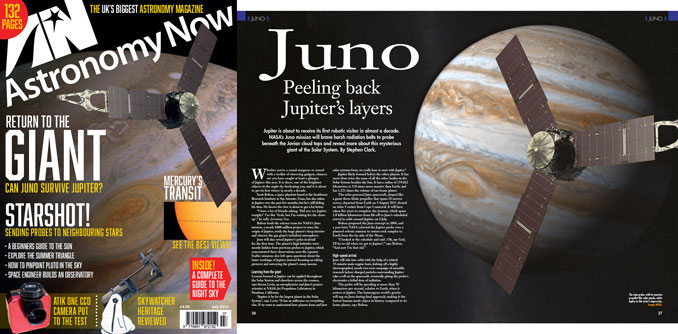A version of this story was originally published in the July issue of Astronomy Now magazine.
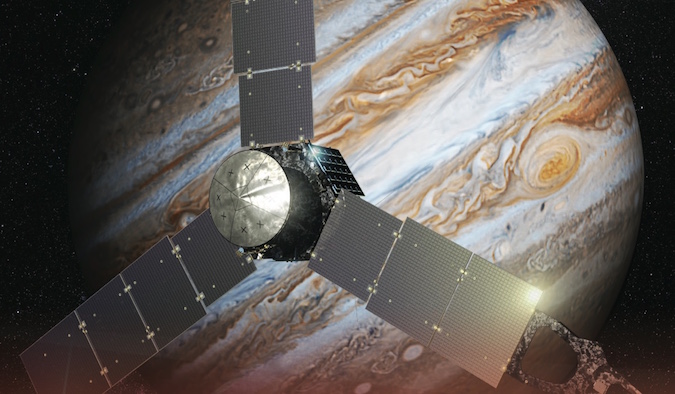
Whether you’re a casual stargazer or armed with a toolkit of observing gadgets, chances are you have caught a glimpse of Jupiter this year beckoning as one of the brightest objects in the night sky.
It’s about to get its first visitor in nearly a decade.
Scott Bolton has also taken in Jupiter over the last few months, but he’s still biding his time. He knows the view is about to get a lot better.
“I have a lot of friends asking, ‘Did you see Jupiter tonight?’ I’m like, ‘Yeah, but I’m waiting for the close-up,'” he said.
Bolton leads the science team for NASA’s Juno mission, a $1.1 billion project to trace the origin of Jupiter, study the huge planet’s deep interior, and observe the gas giant’s turbulent atmosphere.
Named for the wife of Jupiter in Roman mythology, a figure who could see through the cloak of clouds kept by the chief deity, Juno will reveal the gaseous world’s poles in detail for the first time. The planet’s high latitudes were mostly hidden from previous probes to Jupiter, which concentrated their observations near the equator. Earlier missions also left open questions about the inner workings of Jupiter, and instead focused on taking pictures and surveying the planet’s many moons.
Lessons learned at Jupiter can be applied throughout the Solar System, and even elsewhere across the cosmos, said Steven Levin, Juno’s project scientist at NASA’s Jet Propulsion Laboratory in Pasadena, California.
“Jupiter is, by far, the largest planet in the Solar System,” Levin said. “It has an influence on everything else. If we want to understand how planets form and how solar systems form, we really have to start with Jupiter.”
Jupiter likely formed before the other planets, with more than twice the mass of all the other matter in the Solar System besides the Sun. It has a diameter of 139,822 kilometres (86,881 miles) and is 318 times more massive than Earth, containing 1,321 times the volume of our home planet.
The solar-powered Juno spacecraft, shaped like a giant three-blade propeller that spans 20 metres (65 feet) across, departed from Earth on 5 August, 2011, aboard an Atlas 5 rocket from Cape Canaveral. It took five years to complete the journey, which spanned 2.8 billion kilometres (1.7 billion miles) from liftoff to Juno’s scheduled arrival in orbit around Jupiter on 5 July, UK time, 4 July in the United States.
Bolton proposed the Juno concept in 2004, and a year later NASA selected the Jupiter probe over a planned robotic mission to return rock samples to Earth from the far side of the Moon.
“I looked at the schedule and said, ‘Oh, my God, I’ll be so old when we get to Jupiter,'” says Bolton. “And now I’m that old.”
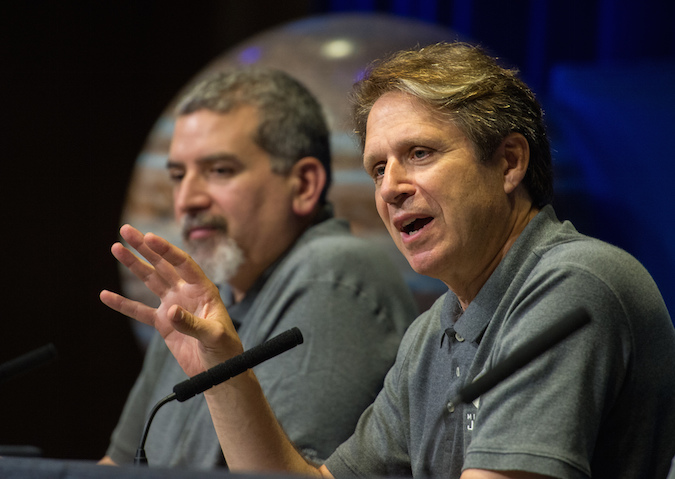
Juno will ride into orbit with the help of a make-or-break 35-minute main engine burn, kicking off a highly-choreographed, nearly two-year campaign of scientific research before charged particles surrounding Jupiter take a toll on the spacecraft, eventually giving the probe’s electronics a lethal dose of radiation.
The probe will be speeding at more than 241,000 kilometers per hour (150,000 mph) relative to Earth when it arrives at Jupiter. The humongous world’s gravity will tug on Juno during final approach, making it the fastest human-made object in history compared to its home planet, said Bolton, a space physicist based at the Southwest Research Institute in San Antonio, Texas.
Engineers should receive confirmation of the start of the critical rocket burn at 0318 GMT Tuesday, and Juno should broadcast a tone at the end of the firing 35 minutes later.
Juno will first enter a preliminary path around Jupiter, taking it several million miles from the planet on an orbit that will take 53 days to complete. Mission planners expect Juno to spend more than three months in that orbit, then adjust down to a lower altitude 19 October.
That is when the probe will commence full-up science observations, employing nine instruments and 29 individual sensors, including a visible camera technically counted as a public outreach tool and not a science payload. In all, Juno will circle Jupiter 37 times before ditching in Jupiter’s atmosphere in February 2018 to end the mission.
Juno is set to become the second spacecraft to survey Jupiter from orbit after NASA’s Galileo mission ended its science campaign in 2003. Researchers got their last close look at Jupiter in 2007, when the New Horizons probe flew by on the way to Pluto.
“There are still an amazing number of basic questions that we don’t have answered about Jupiter, and that’s because it’s hard,” Levin said. “When you look at Jupiter, most of what you’re seeing is the very tops of the clouds in Jupiter’s enormous atmosphere. We have basic questions, like how did Jupiter form? What is its composition?”
Juno will dip inside Jupiter’s radiation belt for most of its mission, but the planet’s uneven gravity will gradually, irreversibly shift the craft’s orbital path, subjecting it to the damaging effects of charged particles suspended in the planet’s magnetic field.
To top it off, the spacecraft, manufactured by Lockheed Martin is spinning once every 30 seconds, providing stability and ensuring instruments mounted around the edges of Juno’s main body get regular looks at Jupiter.
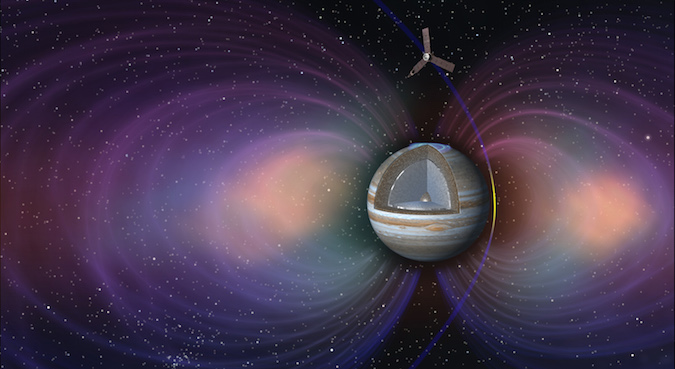
Juno is the first spacecraft to rely on solar power at Jupiter’s distance from the Sun — five times farther away than Earth — paving the way for future missions that could use solar arrays instead of more complex, and costly, nuclear power generators.
“We go in sort of like a dive bomber,” Bolton said. “We go in really fast and get out fast. That speed itself is really hazardous, and we’re also spinning. We’re this giant solar array spacecraft cartwheeling through this incredible magnetic field and radiation belt. It’s a little bit scary.”
Each pass close to Jupiter will take Juno about 5,000 kilometres (3,100 miles) above the planet’s colourful clouds, yielding a few hours of up-close observations before the probe climbs millions of kilometres in its ultimate science orbit. Juno will downlink science data to Earth when it is far from Jupiter, then prepare for the next close approach, or perijove.
Levin likens each perijove as a distinct flyby event because of the short period of time available for premium data collection.
Managers changed Juno’s flight plan after its launch, settling on a final operational orbit lasting 14 days, three days longer than initially envisioned. Scientists say the new plan allows Juno to complete a first look at meeting the mission’s science goals in shorter time than previously anticipated. But it means Juno will need 20 months, five months longer than originally planned, to collect the mission’s full data set.
“Part of it was to give us three days to recover and analyze anything that might happen, so we don’t lose another perijove,” Bolton said. “Perijoves are the part of the orbit that comes very close to Jupiter, and they’re the most precious scientifically.”
One way scientists will investigate Jupiter with the Juno mission is by analysing the radio link between the probe and tracking antennas on Earth. The frequency of the radio transmission will register tiny changes in Juno’s velocity caused by the subtle lumpiness of Jupiter’s gravity, telling scientists about the planet’s deep interior.
Planetary scientists believe Jupiter harbours a solid core of rock and ice, but the hypothesis lacks proof. Juno may resolve that uncertainty.
“We have no direct evidence that it even exists, let alone how big it is,” said Levin, an astrophysicist who helps coordinate the Juno science team’s relationship with NASA.
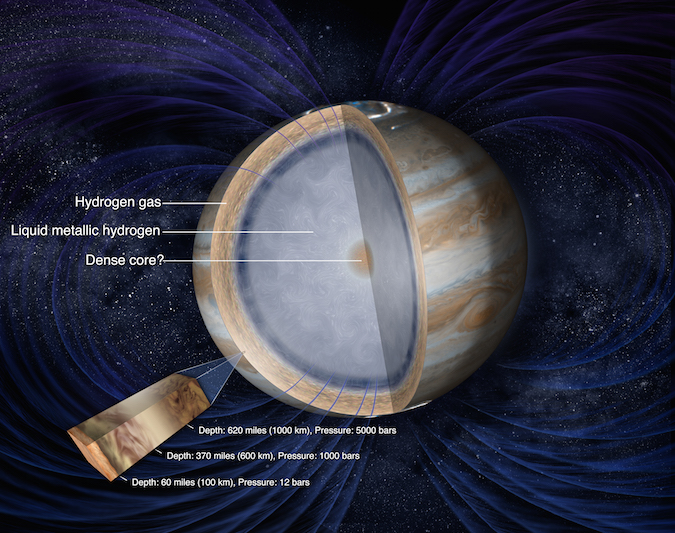
Juno’s instruments will also attempt to track down the source of Jupiter’s powerful magnetic field. Scientists currently think a global pool of liquid metallic hydrogen lies in the middle layer somewhere between Jupiter’s core and atmosphere.
“Think about all three words. Liquid. Metallic. Hydrogen,” Levin said, pausing for effect. “Hydrogen is the lightest element there is. If I filled a balloon here on Earth with it, it would float up into the sky. On Jupiter, the conditions are so intense, the pressure is so high from Jupiter’s enormous gravity, that not only has that hydrogen gas been squeezed down into a liquid, it’s squeezed so much the electrons are coming right off the atoms, so that it conducts electricity. It’s a metal.”
The swirling motion of the hydrogen likely produces the magnetic field, which expands outward and is blown back by the solar wind like a comet’s tail, according to Juno scientists. The magnetic field bubble, called a magnetosphere, is similar to one around Earth, but Jupiter’s is so immense it would be the size of the full moon in the sky, if it was visible with the naked eye.
“The interior of Jupiter is a tough problem for us,” said Tobias Owen, a co-investigator on the Juno mission from the University of Hawaii. “To get deep inside, we have to use indirect methods. We can’t go there. The temperature is too great. The pressure is too high … So what we have to do is to use the radiation thats coming to us from those lower depths to tell us whats going on down there, and this is where Juno comes in.”
Jupiter is a suitable case study for magnetospheric research because Earth’s magnetic field comes from the planet’s molten core, which is farther away from any scientific instrument on Earth’s surface than Juno will be from Jupiter’s supposed ocean of liquid metallic hydrogen.
“When looking at the magnetic field, we should be able to determine whether Jupiter has a solid inner core, and that has profound consequences for how Jupiter formed,” says Jeremy Bloxham, a co-investigator on the Juno science team and professor at Harvard University.
An infrared camera and ultraviolet spectrometer will take pictures of brilliant auroral displays on Jupiter’s poles. At the same time Juno’s particle detectors will help researchers trace the gas giant’s magnetic field lines funneling electrons and ions into Jupiter’s atmosphere, potentially uncovering the mechanism behind the northern and southern lights on the solar system’s king planet.
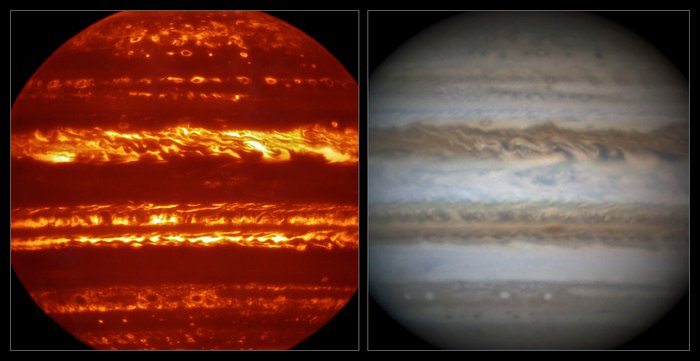
Known for its long-lived storms like the Great Red Spot, a sprawling anticyclonic storm first observed through telescopes in the 1600s, Jupiter’s atmosphere is another subject of the Juno mission. The orbiter’s microwave radiometer, similar to instruments aboard climate satellites looking down on Earth, will collect sounding measurements to peer below the red-orange tapestry of Jupiter’s cloud tops.
The radiometer is tuned to six wavelengths, detecting thermal radiation emitted from different layers of the atmosphere from the storm clouds and jet streams to as deep as 500 kilometres (300 miles).
“We see the Great Red Spot as a storm bigger than the entire Earth,” Levin said. “It’s been around for hundreds of years. We have an idea of what powers that. It’s powered by the heat leaking out from inside Jupiter, but we want to know how deep does that go? How does that mechanism work? We see these belts and zones — jet streams — moving at hundreds of miles per hour around the planet in different directions. What drives that?”
One critical measurement sought by scientists is to quantify the amount of water contained in Jupiter’s atmosphere. The water inside Jupiter is a significant clue about the solar system’s earliest epoch more than 4.5 billion years ago, pointing scientists toward theories about where and how Jupiter formed.
Dust and planetary building blocks coalesced to create Jupiter before any of the other planets formed, and the gas giant’s gravitational influence overwhelmed the rest of the solar system outside of the Sun. Scientists say knowing the conditions of the gas giant’s genesis is essential to understanding how the other planets formed and evolved.
“What Jupiter evidently did as it formed was to scatter cold material that contained water ice and organic materials to the inner Solar System, where it could be captured by the Earth and the other terrestrial planets,” said Jonathan Lunine, a planetary scientist at Cornell University who works on Juno’s science team.
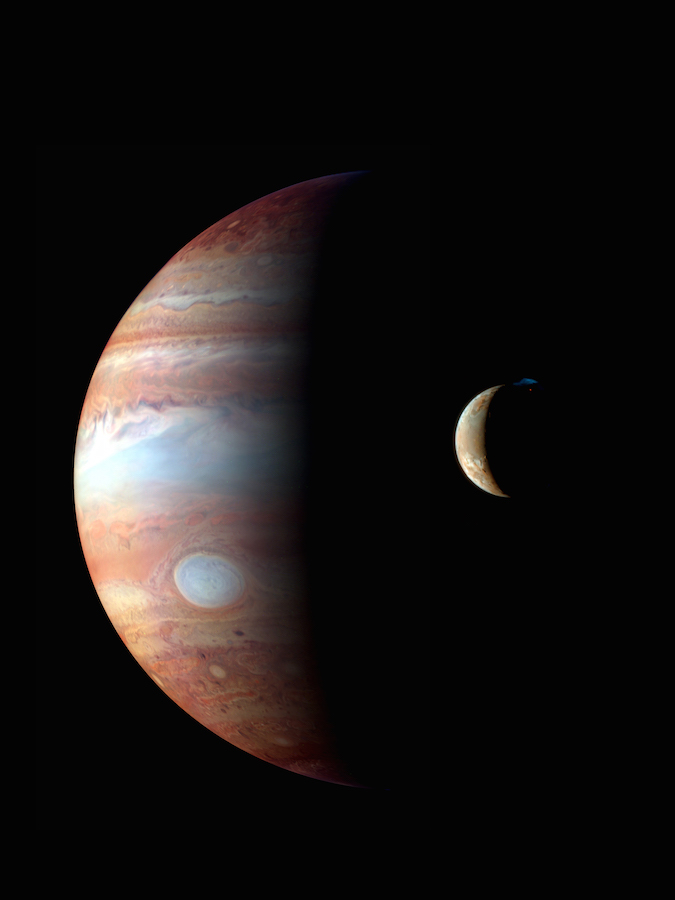
The only data collected from inside Jupiter’s atmosphere came from an entry probe deployed by the Galileo mission in 1995. It found the atmosphere to be hotter and drier than anticipated, causing some scientists to rethink their models on the births of planets.
According to Levin, the consensus now is that the Galileo entry craft plunged into the atmosphere in an especially dry region. If current planetary formation theories are correct, Jupiter should contain more water than suggested by the Galileo probe.
“The most important single number we’re going to measure probably is the global abundance of water,” Levin said.
Juno will end its whirlwind tour of Jupiter in early 2018. That is when engineers predict radiation will degrade the spacecraft’s electronics, prompting a command to dispatch the orbiter to be crushed inside Jupiter’s atmosphere, a purposeful destruction to avoid a chance Juno could contaminate the planet’s potentially habitable moons.
“Some people think we’re crazy, but you’re never going to learn these secrets unless you go in and try,” Bolton said. “And they’re very closely-guarded secrets.”
Email the author.
Follow Stephen Clark on Twitter: @StephenClark1.
Find out more about the Juno mission in the July issue of Astronomy Now. Get your copy in the shops or order online. Or subscribe today and never miss an issue.

